-
PDF
- Split View
-
Views
-
Cite
Cite
Jad Abi-Rafeh, Leila Cattelan, Hong Hao Xu, Brian Bassiri-Tehrani, Roy Kazan, Foad Nahai, Artificial Intelligence–Generated Social Media Content Creation and Management Strategies for Plastic Surgeons, Aesthetic Surgery Journal, Volume 44, Issue 7, July 2024, Pages 769–778, https://doi.org/10.1093/asj/sjae036
Close - Share Icon Share
Abstract
Social media platforms have come to represent integral components of the professional marketing and advertising strategy for plastic surgeons. Effective and consistent content development, however, remains technically demanding and time consuming, prompting most to employ, at non-negligible costs, social media marketing specialists for content planning and development.
In the present study, we aimed to investigate the ability of presently available artificial intelligence (AI) models to assist plastic surgeons in their social media content development and sharing plans.
An AI large language model was prompted on the study's objectives through a series of standardized user interactions. Social media platforms of interest, on which the AI model was prompted, included Instagram, TikTok, and X (formerly Twitter).
A 1-year, entirely AI-generated social media plan, comprising a total of 1091 posts for the 3 aforementioned social media platforms, is presented. Themes of the AI-generated content proposed for each platform were classified in 6 categories, including patient-related, practice-related, educational, “uplifting,” interactive, and promotional posts. Overall, 91 publicly recognized holidays and observant and awareness days were incorporated into the content calendars. The AI model demonstrated an ability to differentiate between the distinct formats of each of the 3 social media platforms investigated, generating unique ideas for each, and providing detailed content development and posting instructions, scripts, and post captions, leveraging features specific to each platform.
By providing detailed and actionable social media content creation and posting plans to plastic surgeons, presently available AI models can be readily leveraged to assist in and significantly alleviate the burden associated with social media account management, content generation, and potentially patient conversion.
Social media platforms have become ubiquitous among patients and physicians alike; platforms such as Instagram (Meta Platforms, Inc., Menlo Park, CA), TikTok (ByteDance Ltd., Beijing, China), and X (formerly Twitter; X Corp, San Francisco, CA) provide users with the unprecedented ability to connect with one another on a global scale.1-4 The prevalence of social media use in plastic surgery in particular has also been on the rise, with various platforms increasingly utilized by plastic surgery journals, training programs, and practitioners as a means of communication, promotion, and education for varied target audiences.5,6 For aesthetic surgeons, social media platforms also have come to represent integral components of their professional marketing and advertising strategy.6-9
In today's society and patient landscape, an active, ethical, and engaging social media presence is often required of aesthetic surgeons in private practice.10,11 Effective strategies to establish trust, proficiency, and stimulate patient engagement are required from the surgeon, all while working to grow a practice, hone surgical skills, and keep abreast of new evidence and techniques.12-16 Managing their own social media pages proves challenging for plastic surgeons; effective and consistent social media content development is both technically demanding and time consuming.11,17 Accordingly, most surgeons tend to employ, at non-negligible costs, social media marketing specialists who can guide content development and manage professional accounts.18
The advent of large language models (LLMs) such as ChatGPT (OpenAI, San Francisco, CA) introduced revolutionary ways in which plastic surgeons may access and leverage the power of artificial intelligence (AI).19-22 Within the medical realm, LLMs showcased impressive creative thinking capabilities by devising medical lecture outlines, informational patient handouts, and generating novel research ideas in response to simple human instruction.19,23-26 An ample amount of clinical applications of AI and LLMs have been explored in plastic surgery, many of which have been published in Aesthetic Surgery Journal.19,21,22,26-41 In the present study we aimed to investigate the ability and potential application of publicly and freely available AI systems to assist plastic surgeons in generating a complete, 1-year social media content development and sharing strategy for 3 of the most common social media platforms, including Instagram, TikTok, and X.42
METHODS
ChatGPT 3.5, representing a freely and readily accessible AI LLM, was prompted during the study period between August and December 2023 to help establish a plastic surgeon's 1-year social media content development and sharing strategy. For each of the aforementioned platforms, ChatGPT was instructed to take on the role of a social media marketing specialist for a plastic surgeon looking to build an online presence for their practice. The stated goal was to maximize patient engagement and traction for the practice, and these instructions were posed from the perspective of the plastic surgeon to the LLM. The model was asked to generate a calendar of daily ideas of content to be shared over an entire year, with outputs requested initially for the month of January, and then monthly for the rest of the year. A sample interaction is presented in Appendix A, available at www.aestheticsurgeryjournal.com.
Serial interactions between the bot and the study's authors ensued to prompt ChatGPT to expand upon and provide step-by-step guidance for the implementation of its suggested content ideas for each platform. No previous training or fine-tuning of the model was performed, and at no time was new information suggested to the bot, nor were alternative instructions provided. Information gathered was compiled for subsequent evaluation and analysis. This included the type of content suggested, the number of themed posts on specific calendar days, and instructions and steps provided for detailed content generation, as well as instances of erroneous outputs.
RESULTS
ChatGPT provided a complete content calendar with 365 daily TikTok and X posts, with content development instructions. Interestingly, for Instagram, it devised a 366-day leap year calendar. All 3 AI-generated content calendars, in their original form as provided by ChatGPT, are presented in Supplemental Tables 1-3, available at www.aestheticsurgeryjournal.com.
Content Theme
Themes of the AI-generated content proposed for each platform were diverse and classified into 1 of the following 6 categories: patient-related posts (eg, before and after pictures), practice-related posts (eg, practice member spotlights), educational posts (eg, procedure explanations), uplifting posts (eg, motivational or humorous posts), interactive posts (eg, polls, quizzes, question-and-answer posts), and promotional content (eg, giveaways, discounts, etc). A detailed breakdown of the proposed content categories, complete with a comprehensive summary of respective post themes, is presented in Supplemental Table 4, available at www.aestheticsurgeryjournal.com. Proportions and distributions of the aforementioned themes differed across the 3 platforms examined (Figure 1). Educational content was most frequently suggested among all 3, with X having the highest proportion of suggested educational content (44.9%, n = 164/365). The second-most frequently proposed category was patient-based content for TikTok (28.2%, n = 103/365) and X (22.7%, n = 83/365), whereas for Instagram, uplifting content was the second-most commonly proposed (21.3%, n = 78/366). Promotional content was the least frequently suggested across all 3 platforms (Instagram: 5.7%, n = 21/366; X: 4.4%, n = 16/365; TikTok: 2.5%, n = 9/365).
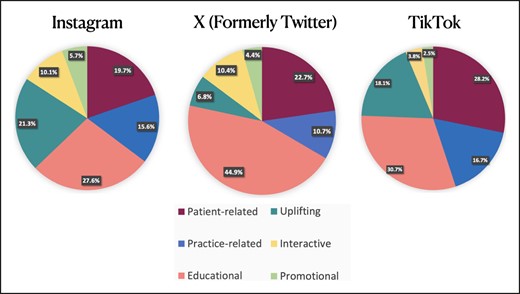
Content distribution of AI-generated content calendars for Instagram, X (formerly Twitter), and TikTok.
Public Holidays and Observant and Awareness Days
In total, ChatGPT incorporated 91 publicly recognized holidays and observant and awareness days in its content calendars, and across all 3 platforms, for the purpose of greater follower engagement. Examples ranged from common celebratory calendar days such as Valentine's Day, Thanksgiving, and Halloween, to observant and awareness days such as Pride, World Cancer Day, and World Suicide Prevention Day. Proposed dates were applicable mostly to the populations of the United States and Canada, with their respective Thanksgiving Days independently provided, for example. In total, 82 of the proposed dates served as inspiration for Instagram posts, 26 for TikTok posts, and 18 for X posts. However, a non-negligible incidence of incorrect dates for the proposed holidays and occasions was encountered, amounting to 22.0% (n = 18/82) for suggested Instagram posts, 22.2% (n = 4/18) for X posts, and 23.1% (n = 6/26) for TikTok posts. The proposed holidays and observant and awareness dates on which uploading posts were suggested, with the associated platforms, are presented in Supplemental Table 5, available at www.aestheticsurgeryjournal.com.
Platform-Specific Suggestions
ChatGPT demonstrated an ability to differentiate between the distinct formats of each of the 3 social media platforms on which it was queried, generating ideas and posting instructions that leveraged features specific to each platform. For Instagram, platform-specific suggestions included “carousels,” “stories,” and “Instagram TV (IGTV)” videos.43 The X calendar saw an emphasis on hashtags, as well as the utilization of Tweet threads.44 As for TikTok, ChatGPT incorporated duets and lip syncs, and invited the user to take part in the community's trends and challenges (Supplemental Tables 1-3, available at www.aestheticsurgeryjournal.com).45
Examples of Detailed Content Creation
With prompting, ChatGPT proved capable of expanding upon its proposed content ideas and providing detailed, step-by-step instructions for the creation of each of the proposed posts on all 3 social media platforms. This included guidance on the types of photographs or videos to produce, script outlines, and creation of captions. For example, for a Black Friday breast augmentation promotional post on Instagram, the LLM provided a 10-step plan for implementation that included planning of offer details, selecting the promotional period, pricing, graphic design, before-and-after photographs, drafting of the promotional message, scheduling of the post, and subsequent monitoring of engagement (Figure 2, and Appendix B, available at www.aestheticsurgeryjournal.com). An example of a video post on Instagram included a 7-step approach to filming collaborative content with a skin care expert; this was complete with a draft email proposal that could be sent to 15 AI-proposed collaborators, as well as a complete script for the post itself (Figure 3, and Appendix C, available at www.aestheticsurgeryjournal.com). For X, a 7-step approach to designing an educational infographic for a rhinoplasty-related tweet was generated, complete with a compelling caption that included key procedure risks and benefits and relevant hashtags (Figure 4, and Appendix D, available at www.aestheticsurgeryjournal.com). An example post on TikTok included a 7-step implement a “Fun Fact Friday” post, discussing and celebrating a celebrity who publicly embraced their plastic surgery journey, sharing the positive impact it had had on their quality of life. It suggested the names of specific celebrities who fit the above criteria, drafted a suggested post caption, and even suggested specific hashtags for greater engagement. (Figure 5, and Appendix E, available at www.aestheticsurgeryjournal.com). A guide on how ChatGPT may be queried to expand upon any of the 1091 posts suggested and presented in the current study (Supplemental Tables 6-8, available at www.aestheticsurgeryjournal.com), across the 3 platforms investigated, is presented in Figure 6.
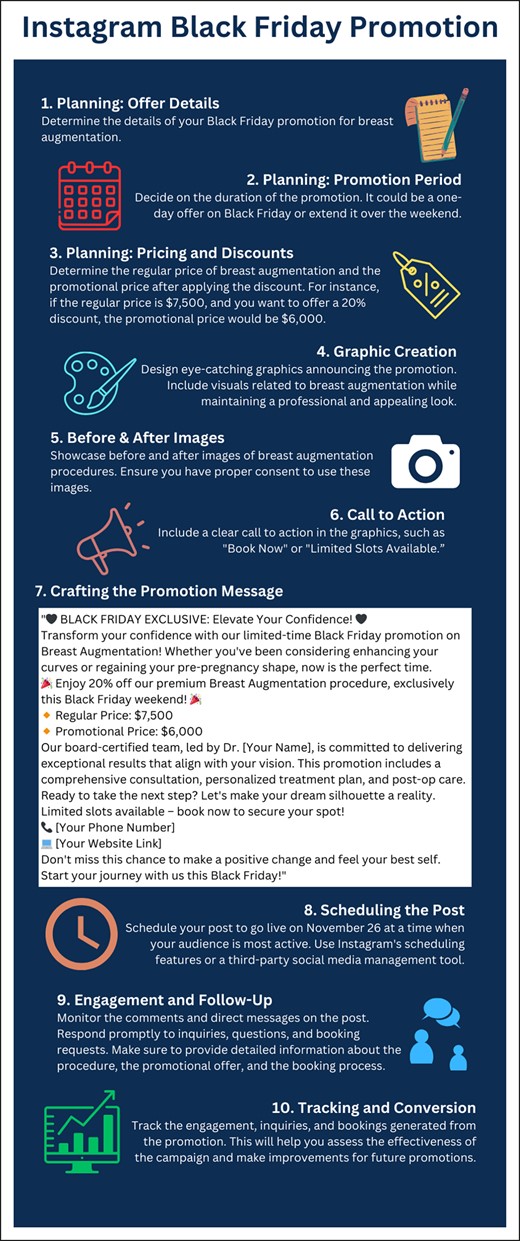
AI-proposed 10-step plan to implement a “Black Friday” Instagram promotion.

AI-proposed 7-step plan to organize a collaborative Instagram video post with a skin care expert.
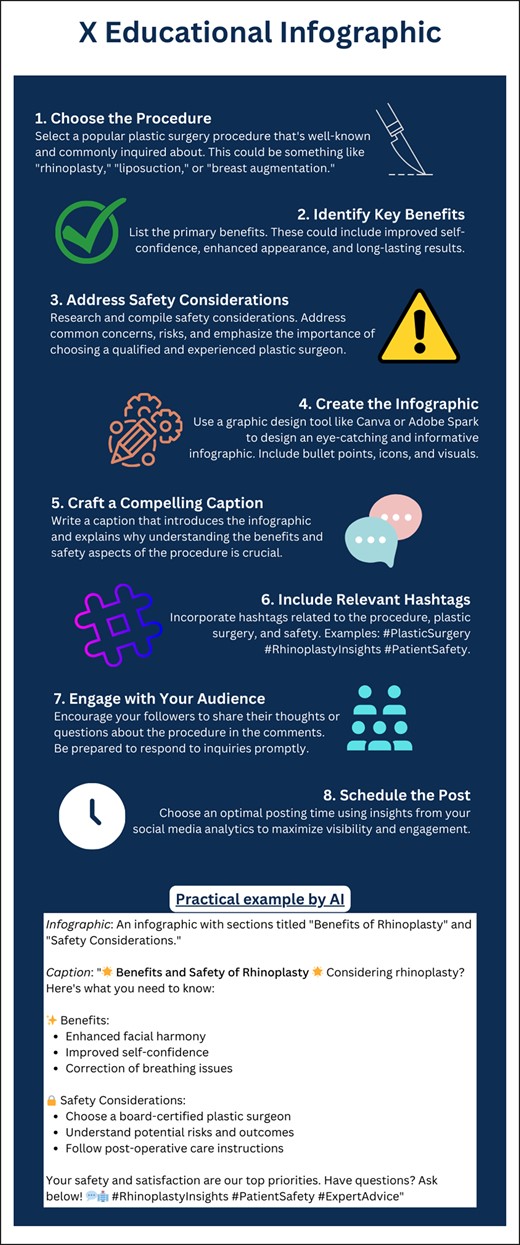
AI-proposed 8-step plan to create an X (formerly Twitter) educational post on rhinoplasty.
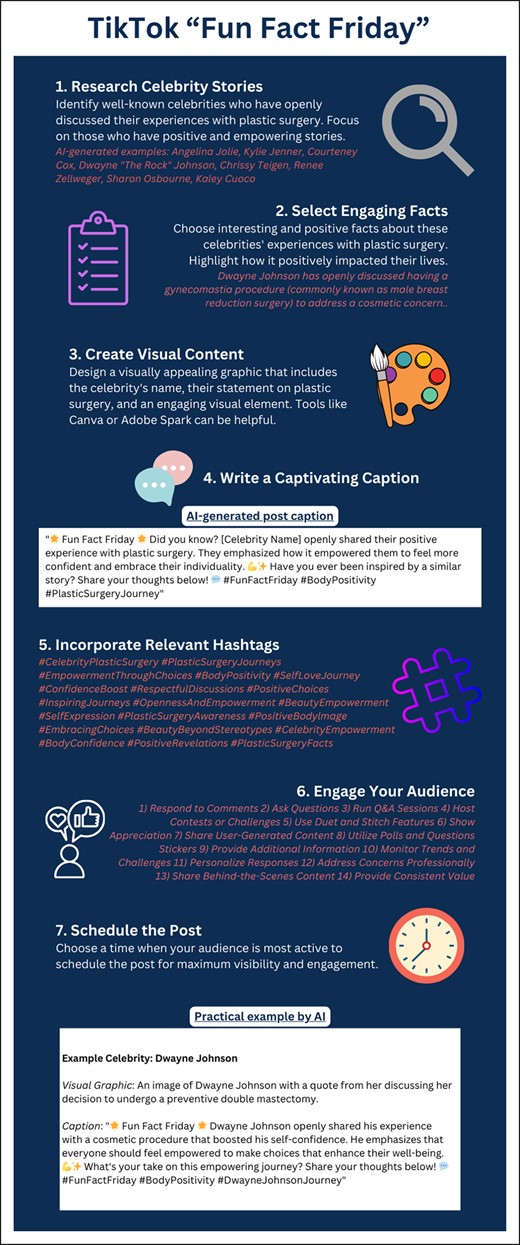
AI-proposed 7-step plan to create a TikTok with the theme of “Fun Fact Friday.”
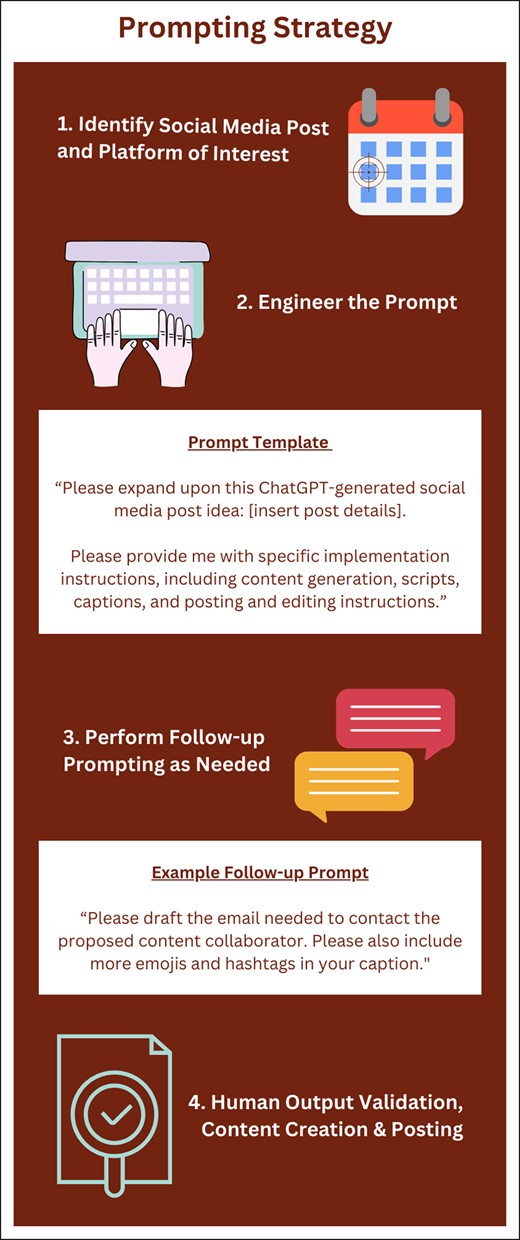
Strategy for prompting ChatGPT to expand upon AI-suggested social media content ideas.
DISCUSSION
Social media platforms represent indispensable tools with which plastic surgeons can establish their reputation, market their expertise, and form relationships with current and potential patients.46-49 The present study evaluates AI's potential application for facilitating the process of social media account management, including content creation and posting strategies for plastic surgeons. By providing detailed and actionable content development and posting plans, currently available AI models may be readily leveraged by plastic surgeons to assist in and significantly alleviate the burden associated with social media account management. The authors include a 1-year, entirely AI-generated social media content development and sharing schedule that plastic surgeons may use for Instagram, TikTok, and X, presented in Supplemental Tables 6-8, available at www.aestheticsurgeryjournal.com.
Performance
ChatGPT successfully generated comprehensive social media posting schedules that included daily content ideas for Instagram, X, and TikTok. Calendars were organized chronologically into monthly tables, with short descriptions of daily post topics and general implementation guidelines for each. The AI model was readily capable of expanding upon any of the 1091 content ideas it had generated, with minimal prompting, facilitating different aspects of content creation. For each idea, step-by-step instructions were laid out, taking the surgeon from content planning to eventual post publication. The bot proved most helpful with idea conception and textual content creation, generating well-written and formatted captions and scripts, complete with relevant hashtags and emojis. It was less capable of assisting with the editing of visual content, providing nonspecific and generic advice (eg, “edit the video,” “design visually appealing graphics”) that may leave inexperienced social media users puzzled and needing further direction, although it did suggest appropriate applications and tools such as Canva (Canva Pty Ltd, Sydney, Australia) and Adobe Spark (Adobe Inc., San Jose, CA). Nonetheless, the model demonstrated an impressive understanding of the features and purpose of each social media platform, as well as their respective target audiences, by suggesting unique content for each, in the appropriate formats. Given Instagram and TikTok's user consumption predominantly tailored toward entertainment and amusement through photographs and videos, a greater proportion of “uplifting” content was suggested on their posting calendars relative to X. The latter's focus on short-form informative content, given its 280 tweet character limit, was recognized by the AI model, with a greater relative proportion of suggested educational posts (Figure 1).50
The LLM assigned recurring content themes to different days of the week such as “Motivation Mondays,” “Wellness Wednesdays,” and “Throwback Thursdays,” with content examples including motivational quotes, self-care tips, and memorable photographs and footage from past events and personal milestones, respectively. For the Instagram and TikTok content calendars, the bot also incorporated iterative content under the form of “video series” encompassing a variety of topics that would progress throughout the year. This provided additional meaning and context to the individual posts, while establishing a sense of cohesiveness and routine that could be anticipated by regular viewers and increase engagement. Numerous festive and commemorative occasions and holidays were incorporated into the content calendars, serving as inspiration for more tailored content. The AI model proved capable of adapting its suggested content to a given celebratory theme. For instance, on World Environment Day, it suggested content promoting sustainable and environmentally conscious skin care choices, encouraging followers to share eco-friendly habits and tips.
Educational Posts
AI-generated educational post ideas ranged from short videos explaining indications and benefits of popular aesthetic procedures, debunking common medical misconceptions, to creation of eye-catching infographics and photograph carousels discussing preoperative preparation for surgery or postoperative recovery, for example. The LLM also encouraged interaction with followers by responding to comments on the platform, and “dueting” their followers’ videos on TikTok to further share answers to frequently asked questions. The bot proposed that a series entitled “Inside the Operating Room” be started in which “behind-the-scenes” footage was shared with followers, providing a glimpse into the surgical steps and postoperative care of several common procedures. The LLM suggested a recurring series of posts on “Weekend Readings,” in which the surgeon would share recommended new articles and books about several relevant topics in plastic surgery, aesthetics, or self-improvement, with brief summaries of each. The model consistently emphasized that the surgeon employ clear and simple language in all educational posts in consideration of a layperson target audience (Supplemental Tables 6-8, available at www.aestheticsurgeryjournal.com).
Patient-Related Posts
The LLM suggested that positive patient reviews and postoperative results be shared in the form of carousel before-and-after photographs on Instagram, as well as through video footage documenting patient transformations on the other platforms. The bot suggested soliciting written or filmed testimonials from patients that may be shared on any of the 3 platforms, describing positive experiences and the impact that their transformations had had on their self-confidence and daily lives. The importance of obtaining patient consent and prioritizing patients’ wishes was repeated when suggesting any patient-related content, demonstrating an understanding of the ethical and medicolegal principles to which physicians are bound (Supplemental Tables 6-8, available at www.aestheticsurgeryjournal.com).51
Uplifting Posts
Post ideas in this category focused on the promotion of wellness, motivation, and self-confidence among the surgeon's followers. These included the sharing of motivational quotes, as well as photographs and footage of inspirational moments from the surgeon's day-to-day life. The latter ranged from exercise routines to healthy recipes and stress-relief techniques. It was suggested that many of these posts be scheduled on specific days of the week as part of a recurrent theme, to promote consistency and engagement from followers; these included “#SelfLoveSundays” and “#WellnessWednesdays,” as 2 notable examples. More specific propositions included the celebration of International Women's Day, by highlighting achievements of the practice's female staff, and placing the spotlight on the practice's nursing team on National Nurses’ Day. It suggested celebrating the practice's linguistic diversity and inclusion by sharing a video of different team members greeting patients in various languages. When suggesting humorous content such as good-natured office pranks on April Fool's Day, the AI model emphasized the need to ensure ethical practice, professionalism, and post quality control (Supplemental Tables 6-8, available at www.aestheticsurgeryjournal.com).
Practice-Related Posts
The LLM suggested multiple ways in which the practice might be featured and promoted through social media. The model suggested posting photographs and videos as part of a series of “Team Spotlights,” featuring all team members, from surgeons to nurses and support staff. Other content ideas included “#ThrowbackThursday” posts consisting of photographs and videos of past milestones or achievements of the surgeon and practice. These included the passing of medical and surgical board examinations, presentations at notable conferences, or the early days of practice, to celebrate growth and progression. The LLM also suggested virtual tours of the office spaces to draw attention to any state-of-the-art equipment within the practice, as well as patient-friendly amenities (Supplemental Tables 6-8, available at www.aestheticsurgeryjournal.com).
Interactive Posts
The LLM proposed several avenues for directly stimulating follower engagement. It utilized readily available platform features such as question polls on Instagram and X, quizzes, question stickers, and Instagram and TikTok “lives.” The AI model suggested that polls and quizzes be developed to gather information on patient content preferences, or to test their knowledge on popular procedures or misconceptions. Question stickers were suggested to provide followers with a direct way to interact with the practice and its surgeon, based on which new posts might be created. Finally, live streaming features on the different platforms were suggested to host live question and answer sessions with followers, and for speaking events in collaboration with nutritionists, dieticians, or skin care experts (Supplemental Tables 6-8, available at www.aestheticsurgeryjournal.com).
Promotional Posts
Promotional posts represented the least commonly suggested category. Propositions included discounts for special occasions such as Father's Day, graduation specials, Valentine's Day packages, and Mother's Day mommy-makeover specials. Contests were also suggested, with associated prizes, such as a “Halloween Costume Contest” or a “Summer Selfie Contest.” Other ideas included a “Black Friday 20% Discount Special,” as well as a “3.14% Pi Day Discount” on procedures (Supplemental Tables 6-8, available at www.aestheticsurgeryjournal.com).
Performance Pitfalls and Limitations
Due to the comprehensive nature of the requested information, including the generation of a total of 1091 social media posts, premature response termination was repeatedly encountered when querying for the long posting calendars. This represents a known performance limitation officially disclosed by the bot's developer, in which the LLM fails to provide a complete response in the case of lengthy responses on the order of thousands of words, encountered in tasks such as generating a full year's worth of social media content generation and posting strategies for 3 platforms.52 This performance limitation is related to the maximum number of “tokens,” or units of text, that the model is able to use for a given question and answer, or query iteration. If this token limit is exceeded in a response, iterative follow-up prompting is necessary to allow the model to complete this response with new tokens from another query iteration. This proved necessary at multiple points in the present study, and represents a performance limitation worthy of discussion. However, it is expected that this limitation will be addressed as the models are improved by developers, with an increase in the maximum amounts of tokens permitted for each query between user and LLM. Furthermore, several instances of erroneous and occasionally nonsensical suggestions were encountered, with a non-negligible proportion of holiday and observant and awareness days that are not officially recognized, such as “National Sleep Day.” Content calendars saw instances of dates associated with the wrong day of the week (eg, Sunday followed by Tuesday for August 15 and 16, on the proposed Instagram calendar). Although these are minor mistakes, they underscore the importance of continuous human validation of AI output, because any lapses may potentially lead to a compromised practice or surgeon public image. ChatGPT-3.5's knowledge cutoff of 2021 represented an added limitation, affecting both the accuracy of dates for holidays, and accuracy in nomenclature when discussing evolving features of the different platforms (eg, making reference to “IGTV,” which was discontinued by Instagram and replaced with “Reels” in early 2022).53,54 It proved unaware of recent increases in TikTok video length allowances (from an original maximum of 15 seconds to its current 10-minute allowance), as well as the incorporation of the photograph carousel feature on TikTok, something originally unique to Instagram.55-57
CONCLUSIONS
The present article reports on the ability of AI to assist in the development of a social media marketing strategy for plastic surgeons seeking to grow and maintain their online presence, with an entirely AI-generated social media content development and posting strategy presented here. Future studies may seek to validate and optimize this AI-generated material with respect to social media user engagement, post analytics, and follower-to-patient conversion. Current models’ limitations emphasize the need for continued human supervision, while the rapidly developing field of AI promises future iterations of this technology that can further automate the process of content creation, editing, sharing, and social media strategy optimization in response to real-time follower engagement and patient conversion data.
Supplemental Material
This article contains supplemental material located online at www.aestheticsurgeryjournal.com.
Disclosures
The authors declared no potential conflicts of interest with respect to the research, authorship, and publication of this article. Dr Foad Nahai is the immediate past Editor-in-Chief of Aesthetic Surgery Journal (ASJ) and serves on the ASJ editorial board as aneditor emeritus.
Funding
The authors received no financial support for the research, authorship, and publication of this article.
REFERENCES
Author notes
Dr Abi-Rafeh is a resident, Division of Plastic, Reconstructive, and Aesthetic Surgery, McGill University Health Centre, Montreal, Quebec, Canada.
Dr Cattelan is a resident, Department of Medicine, McGill University Health Centre, Montreal, Quebec, Canada.
Mr Xu is a medical student, Faculty of Medicine, Laval University, Quebec City, Quebec, Canada.
Dr Bassiri-Tehrani is a plastic surgeon in private practice, New York, NY.
Dr Kazan is a plastic surgeon, Division of Plastic, Reconstructive, and Aesthetic Surgery, McGill University Health Centre, Montreal, Quebec, Canada.
Dr Nahai is a professor, Division of Plastic and Reconstructive Surgery, Emory University School of Medicine, Atlanta, GA and is an editor emeritus for Aesthetic Surgery Journal.



